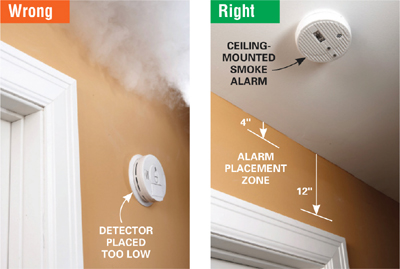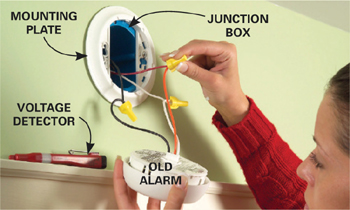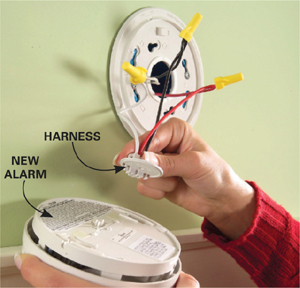No. 28
Replace smoke alarms
Basic know-how saves lives
If you knew you could drastically reduce your risk of death and destruction just by installing and maintaining a few cheap gadgets, you would do it—right? Well, lots of people don’t. About 60 percent of house-fire fatalities occur in homes with missing or neglected smoke alarms. To avoid becoming a statistic, you just need to know—and do—a few simple things.

Where to put them
Install at least one alarm on each level of a home, including one in each bedroom and one in each hallway leading to bedrooms. That’s not just good practice; it’s required by most building codes.
Smoke rises, so alarms must be close to the ceiling, but not too close. Place wall-mounted alarms 4 to 12 in. from the ceiling. Keep ceiling-mounted alarms at least 4 in. from walls.
Replace a hard-wired alarm
Even if you’re a wiring rookie, consider doing this job yourself. It’s is one of the easiest electrical projects there is, and you’ll save the cost of hiring an electrician. The key to doing it safely is to first turn off the power at the main panel and then make sure it’s off by touching wires in the junction box with a voltage detector (about $5)—it will beep or light up if power is present.

1. Remove the old alarm
Rotate the alarm to remove it from the mounting plate. Disconnect the wires by unscrewing the connectors. Then unscrew the old mounting plate from the junction box.

2. Install the new alarm
Screw on the new mounting plate, connect the new wiring harness to wires coming out of the wall and plug the harness into the alarm. Mount the alarm on its plate and you’re done.
They don’t last forever
After 10 years or so, alarms become unreliable and should be replaced. To check an alarm’s age, just remove it from its mounting plate (usually by turning it counterclockwise). On the back, you should find a manufacture date. If not, replace the alarm. And don’t forget to change the dead batteries!
There are two types
Before you replace an alarm, you have to know how it’s powered. Some alarms are powered by batteries only. Others are “hard-wired” to your home’s power supply and have batteries for backup power. Hard-wired alarms are usually interconnected; if one detects smoke, they all scream. To tell what kind you have, remove it from the mounting plate. If it’s connected to wires, it’s hard-wired. If it’s connected to three wires, it’s an interconnected model. In that case, you should replace it and all of its neighbors with identical alarms.


